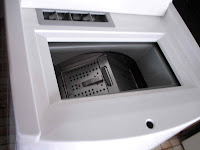
A year ago, after much research, we ordered a Staber washer, made in Ohio and built to last 25 years. It's a top-loader that runs like a front-loader. After you close the top of the basket with your laundry in it, it rotates on a horizontal axis. Though this type of machine is popular in Europe, the Staber is the only one made in the U.S.
It's on the Energy Star list of efficient washers. It's not in the very highest efficiency Energy Star tier because Energy Star doesn't subtract the agitator to judge volume (an ordinary top-loader with this drum size could not hold a full load). Yet it holds a full load (approx. 18 pounds), because we can fill it completely full since there is no agitator and no front-door gasket to avoid (front-loaders often leak when clothes get caught in the door gasket). So it uses less energy, less water and much less normal detergent than most washers, and it does a load in about the same amount of time as our old top-loader. See http://www.staber.com and be sure to watch the video.
The Staber sounded superior to any other washers sold in the U.S. from the specs and the testimonials and forums I read, including Consumer Reports forums (it wasn't included in their tests). It also has the critical advantage of fitting in our small laundry room. Our distant second choice was the Fisher & Paykel Intuitive Eco top loader with flex agitator, but the brand seems to require frequent repairs. Third choice was the Whirlpool LHW0050 front-loader, but while the measurements seemed about right, I wasn't sure that our laundry room doors would have given the front door enough clearance, and front-loader door gaskets seem to require frequent cleaning with bleach to prevent mold.
We wash the laundry only in cold water, and the Staber does a better job in cold water than our old top-loading washers. It is gentler on the clothes too, since there is no agitator to stretch or pull them. It gets more soap out of the clothes, which pleases my sensitive skin. After using it for a year, we are both still very pleased with it.
After washing a load in the Staber, it's already much dryer from the spin cycle than any washer I've used. With that and the dryer duct replacement and vent cleaning, the laundry dries much sooner. We switched to using the dryer's dryness sensor instead of its timed drying cycle, which makes so much sense I keep having "I could have had a V-8" moments for not switching sooner. Since the clothes are not being overheated, they are not shrinking as much and they are softer.

 After the FloodStop arrived, we installed its shut-off valves on both the hot and cold water faucets. We plugged the valves into the control unit. We plugged the moisture sensor into the control unit. We plugged the control unit into the power outlet. We rested the moisture sensor on the floor.
After the FloodStop arrived, we installed its shut-off valves on both the hot and cold water faucets. We plugged the valves into the control unit. We plugged the moisture sensor into the control unit. We plugged the control unit into the power outlet. We rested the moisture sensor on the floor.




